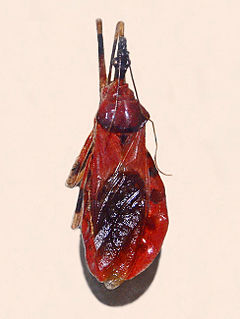
Pentatomidae is a family of insects belonging to the order Hemiptera, generally called shield bugs or stink bugs. Pentatomidae is the largest family in the superfamily Pentatomoidea, and contains around 900 genera and over 4700 species. As hemipterans, the pentatomids have piercing sucking mouthparts, and most are phytophagous, including several species which are severe pests on agricultural crops. However, some species, particularly in the subfamily Asopinae, are predatory and may be considered beneficial.

Pentatominae is a subfamily of Pentatomidae, a family of shield bugs. This subfamily is the largest one within the pentatomidae, having 4937 species. classified in 938 genera. Species on this subfamily are phytophages and several of them have been considered agricultural pests. Some invasive pentatomines such as Halyomorpha halys and Bagrada hilaris have been considered household pests, even inflicting adventitious bites. Higher systematics of the group has been revised by Rider et al.

Zygogramma is a large genus of leaf beetles in the subfamily Chrysomelinae, which includes approximately 100 species. 13 species occur north of Mexico.

The Harpactorinae are a large subfamily of the Reduviidae. About 300 genera and 2,000 species worldwide have been described. Some of the species of the genera Zelus, Pselliopus, Sinea, and Apiomerus are of interest as biological pest control agents.

Harpactorini is a tribe of the Harpactorinae. This group is the most diverse of the entire assassin bug family, with 51 genera recognized in the Neotropical Region and 289 genera and 2003 species overall.

Sphedanolestes is a large genus of assassin bugs in the family (Reduviidae), subfamily Harpactorinae. There are more than 190 described species, which are found in southern Europe, Africa and Asia.

Rhynocoris is a genus of assassin bug, family (Reduviidae), in the subfamily Harpactorinae. Species are recorded from Asia, mainland Europe, Africa and North America.

The Reduviinae are a subfamily of the reduviid assassin bugs. Many members of the subfamily are nocturnal and their lifecycles are generally poorly known. This subfamily is suspected not to be monophyletic.

Euagoras is a genus of assassin bugs, in the subfamily Harpactorinae. Species are found in Asia and Australia.

Acanthaspis is a genus of assassin bugs. Members of the genus are known to disguise themselves by attaching bits of debris to aid in camouflage.

Eulyes is a genus of true assassin bugs belonging to the family Reduviidae.

Laccotrephes is a genus of water scorpion belonging to the family Nepidae. They are carnivorous insects that hunt near the water surface. They are not aggressive, but may inflict a painful bite if not handled carefully, which may cause a local reaction. There are about 60 species found in shallow stagnant or slow-moving waters in warm parts of Africa, Asia and Australia.

Dysdercus is a widespread genus of true bugs in the family Pyrrhocoridae; a number of species attacking cotton bolls may be called "cotton stainers".
Melamphaus is an Old World genus of true bugs in the family Pyrrhocoridae, the cotton stainers. They are often confused with bugs in the family Lygaeidae, but can be distinguished by the lack of ocelli on the head.

Coranus is a genus of assassin bugs in the tribe Harpactorini.

Calligrapha is a genus of large American Chrysomelinae of imprecise taxonomic boundaries. Most species occur in Central and South America.

Tessaratoma is a genus of bugs in the family Tessaratomidae. There are more than 20 described species in Tessaratoma.

Epidaus is a genus of assassin bugs with about 25 species mainly distributed mainly in the Oriental Realm with two species which extend into the Palearctic Realm. Most species have a long and narrow body with the pronotum having a posterior margin with raised corners and spiny outgrowths facing outwards. The head a tubercle behind the base of each of the two antennae.
















